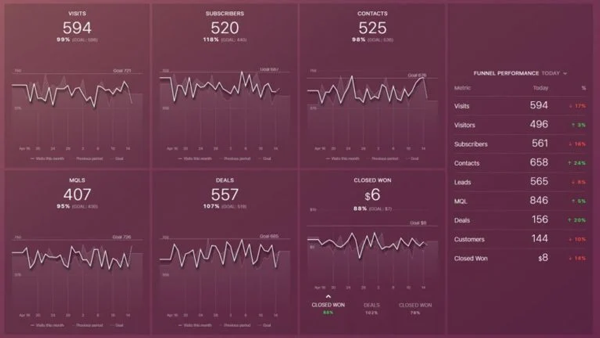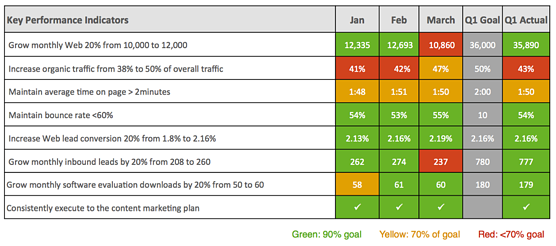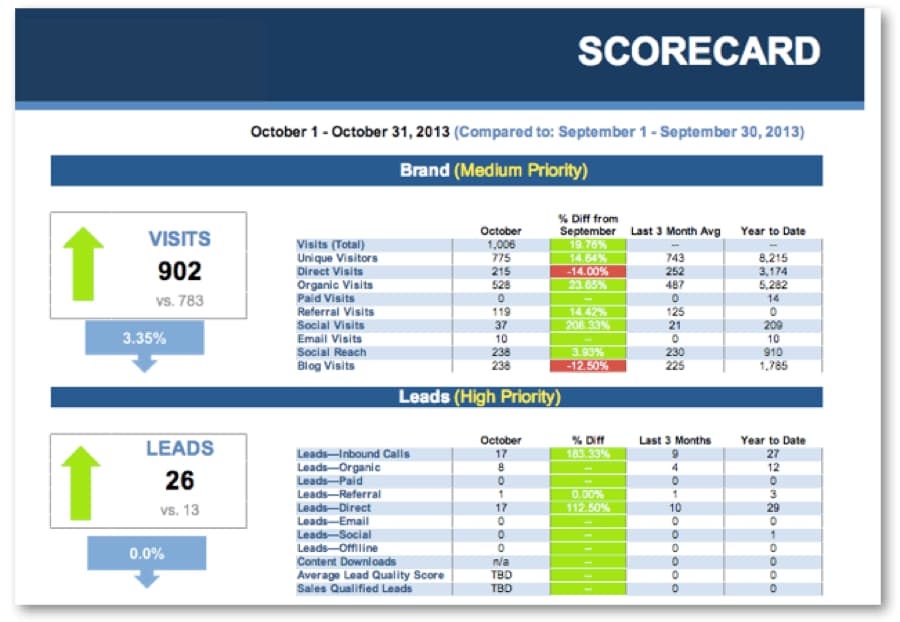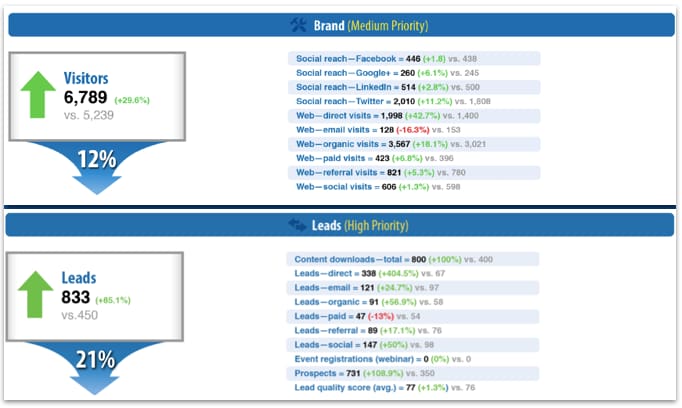
Written By:
Sean Henri
A marketing scorecard is a data-driven marketing measurement tool that aligns activities to business strategy and allows teams to monitor their progress towards goals and improve their marketing efforts over time.
Scorecards tend to come in the form of a spreadsheet so that they can store large sets of historical data, while keeping the focus on the current span of time.
A scorecard may be accompanied by a dashboard, but the key distinction between a dashboard and a scorecard is that the scorecard puts the emphasis on set time periods or sprints of work (eg. M-F, Week 1, Month 1, etc.), so that teams can stay on top of their progress towards a predetermined goal.
Key Takeaways
Align to strategy: Scorecards tie marketing activities to business objectives through clear KPIs and targets.
Track in sprints: Weekly or monthly snapshots reveal progress early and keep teams agile.
Include essentials: List KPIs per objective, set goals, note leading indicators, and log period performance.
Add context wisely: %-to-goal, period deltas, and key observations deepen insight without overcomplicating.
Drive accountability: Visible, routinely updated scorecards keep teams focused, data-driven, and surprise-free.
What Goes into a Marketing Scorecard?
While scorecards can take many different shapes and sizes, a perfect marketing scorecard will always contain the following elements:
- Key Performance Indicators (KPIs), broken down by major objective
- A goal or target for each KPI
- Leading indicators
- Performance, broken down by week (or month/quarter, etc.)
If you are deploying a marketing scorecard to track your inbound marketing efforts, three common objectives to include are attracting visitors to your website, converting those visitors into leads, and transforming leads into customers. In this scenario, the three most appropriate KPIs to measure progress towards those goals would likely include the number of visits, leads and customers generated in a given period of time.
Optionally, you may want to strengthen your scorecard by adding some context and a story to your data. You can do this by incorporating the following elements:
- % towards goal
- % change over previous period
- Observations on what worked and what didn’t
While the additional context can be valuable, you want to be careful to keep your scorecards simple to maintain and easy to understand. Otherwise, you may risk making the tool too burdensome to keep up with over time.
If you cannot include the additional context without making the tool too complex, make a point to touch on these three items when sharing the results of your scorecard with others.
Examples of Effective Marketing Scorecards
Here are four examples of effective marketing scorecards that you can draw inspiration from when creating your own:
1)

This scorecard we created at Pepperland outlines KPIs like the number of website visits, marketing qualified leads, and deals closed over the past month. What sets this scorecard apart is the graphical representation which makes it visually clear where we are in comparison to our historical performance and our goals for the month.
2)

This scorecard from TREW Marketing does a great job of aligning KPIs with marketing goals. Each marketing goal listed is followed by metrics highlighted in green, yellow, or red to instantly convey whether or not the goals are being met.
3)

We love this scorecard by Business 2 Community. It breaks down web visits by their type, and because of this, you can really zero in on the specific traffic sources that need work and those that are outperforming. From there, you can guide your marketing efforts for the next period.
4)

This marketing scorecard by PR 20/20 effectively outlines KPI including web and social visitors, and also does a great job of capturing whether or not those visitors are converting. We love the addition of lead quality score, which determines the value of the leads you’re getting.
How Scorecards Drive Action
The main benefit behind maintaining a well-thought-through marketing scorecard is that it keeps everyone on your team aligned to your strategic objectives, and keeps focus on progress towards goals.
“Measurement is the first step that leads to control and eventually to improvement. If you can’t measure something, you can’t understand it. If you can’t understand it, you can’t control it. If you can’t control it, you can’t improve it.” — H. James Harrington
Unlike a report in Google Analytics or some other tool, a scorecard is highly visible, manually updated, and reviewed at least weekly.
Without the regular focus on performance that a scorecard brings, teams tend to fall in the monthly or quarterly habit of forgetting about measurement until it’s too late. There’s nothing worse than pulling up a campaign report and suddenly realizing that things went haywire two weeks ago when it’s time to report on results.
Additionally, by capturing scores in small sprints of time, each contributor can have a greater sense of how their actions this week, or even today, are contributing towards broader goals.
The Bottom Line
Once you’ve created your marketing scorecard, you and your team will be on your way to becoming a highly accountable data-driven team that’s focused on exceeding objectives and producing results.







